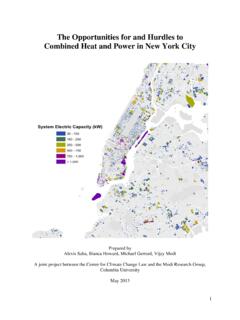Transcription of Combined Heat and Power for Industrial Revitalization
1 CCAPCENTER FOR CLEAN AIR POLICYD ialogue. Insight. BY:Thomas Simchak, Stacey DavisJULY 2013 WHITE PAPER: Combined heat AND Power FOR Industrial REVITALIZATIONP olicy Solutions to Overcome Barriers and Foster Greater Deploymenti Acknowledgements This paper was authored by Tom Simchak and Stacey Davis. It was made possible with the generous support of the Energy Foundation, the BP Foundation, and the members of CCAP s Climate Policy Initiative. The authors would like to thank the participants of the Climate Policy Initiative for their valuable insight into the issues discussed in this paper, as well as Jen Derstine and Tom Dower for their valuable assistance. The views expressed in this paper represent those of CCAP and not necessarily those of any of the other institutions or individuals mentioned above.
2 For further information, please contact Tom Simchak at About the Center for Clean Air Policy The Center for Clean Air Policy works to develop climate and air quality policy solutions in the and around the world that are effective at reducing pollution and cost-effective while addressing the needs of key stakeholders. Through our multi-stakeholder Climate Policy Initiative dialogues, CCAP has helped stakeholders affected by regulations, better understand the ability of the Clean Air Act to enable flexible approaches to greenhouse gas emissions regulation while also advancing viable solutions. CCAP is focusing on policies to improve the energy efficiency and competitiveness of industry, particularly by identifying effective and politically viable approaches to encourage Combined heat and Power .
3 In 2013, CCAP s policy agenda builds on the relationships we have established with industry, NGOs, and government agencies to promote climate change policies through the lens of Industrial competitiveness, and to appeal to corporations self interest in the economic realities of this tough economy. CCAP provides these stakeholders with a forum for discussion among leading industry representatives, NGOs, and agency officials on how to reduce greenhouse gas emissions through policies that enhance Industrial , competitiveness, innovation and efficiency. ii Contents Acknowledgements .. i About the Center for Clean Air Policy .. i Contents .. ii Executive Summary .. iii Introduction .. 1 CHP: A Primer .. 4 Benefits of CHP .. 6 CHP in the .. 7 Economics of CHP .. 10 A Window of Opportunity for CHP.
4 12 Barriers to CHP .. 15 Solutions .. 18 21 Appendices .. 22 Bibliography & Additional Resources .. 31 iii Executive Summary Improved Industrial efficiency can play a crucial role in boosting international competitiveness, protecting jobs, and reducing the sector s carbon intensity. Combined heat and Power (CHP) in particular can significantly improve the overall efficiency of electricity and thermal energy production, bringing benefits to both the company that installs the technology and more broadly. While improving efficiency by reducing waste, CHP offers a number of benefits, including cost savings, improved manufacturing competitiveness, job creation and maintenance, improvements to the robustness and security of the electrical grid, and reduction in environmental impacts like greenhouse gas emissions.
5 Crafting policies and regulations to allow or encourage use of CHP in meeting emissions regulations like the EPA s Boiler MACT1 and in states implementation plans under the Clean Air Act can make the goals of those regulations more attainable in a cost-effective manner. Despite these advantages, a number of barriers impede greater deployment of CHP: Utilities are often unwilling to support CHP or to ease the process for CHP facilities to connect to the electrical grid as utility business models are, in most markets, based on selling as much electricity as possible to maximize the return on their investments. The technical requirements and process for interconnecting to the grid are often non-standardized and obtuse, slowing the process and increasing costs. Electric utilities may charge Industrial CHP producers high standby rates to keep electricity service available for times the CHP equipment is not operating.
6 These rates can be sufficiently large as to harm the cost-effectiveness of some projects. The up-front capital expenditures to install CHP systems can pose a barrier even when the investment is expected to be cash positive within a longer period. In some instances, a firm would be able to meet the costs of a CHP project, but the investment in CHP may be competing with other possible investments. In other cases, the company may not have access to capital or financing. Despite the environmental benefits, CHP facilities face much of the same permitting requirements as more traditional boilers and generation equipment, including emissions regulations and requirements for siting. Companies may lack the expertise or institutional capacity to plan, install, and operate CHP equipment.
7 Many states across the country have been implementing policies that help remove or compensate for these barriers, supporting growth in CHP and other energy efficiency and distributed generation technologies. The Federal government has also been taking action, mainly through outreach and education, as state regulatory authorities have primary jurisdiction over many of the key decisions affecting the viability of CHP technology. Model state policies may provide lessons for other states and 1 Maximum available control technology or by its proper name, Industrial / Commercial / Institutional Boiler National Emissions Standards for Hazardous Air Pollutants iv for the Federal government, helping to establish best practices that can be adapted and adopted by others to boost deployment of effective, efficient, and equitable solutions.
8 To fully realize the potential benefits of CHP, action is needed across government jurisdictions to open the market and encourage this technology. The following policy solutions can foster enhanced deployment of CHP: Standardize the rules and regulations for interconnection to the electrical grid. Regulate standby rates to ensure costs are predictable and fair. Align utility business models to bring the interests of the utilities in line with the benefits of CHP. Ease access to financing and employ tax or other incentives to help companies deploying CHP to address the high up-front capital costs. Require deployment of clean energy sources like CHP with clean energy standards. Ensure metering requirements and rates for electricity sold to the grid are fair and recognize the benefits that CHP can provide for grid stability and operation.
9 Streamline permitting processes to make permitting predictable and less costly. Recognize the efficiency and environmental benefits of CHP by allowing this technology to be used as a means of compliance with air quality regulations, including greenhouse gas regulations. Expand outreach and education to inform potential CHP users of the benefits of CHP and how to install CHP systems in their facilities; inform utilities how to effectively incorporate distributed CHP into their electricity grids in a cost-effective manner that ensures grid stability and financial viability. Install CHP systems at federal government facilities as an example for the private sector and to reduce energy costs paid by taxpayers. This paper highlights the advantages of CHP in improving Industrial competitiveness and environmental quality.
10 It examines current and potential levels of CHP deployment in the Industrial sector along with key economic and policy drivers, discusses barriers to greater CHP penetration, and identifies a number of policy actions that can mitigate these barriers. In particular, federal and state governments (and where relevant, non-governmental actors like grid operators) should focus on policies that remove the main barriers to CHP deployment and improve conditions for private investment in ways that are fair to utilities and ratepayers. 1 Introduction The domestic manufacturing sector has come under increasing competitive pressure in recent years. Off shoring of the manufacturing sector,2 along with difficulties brought by the economic downturn, have challenged the domestic Industrial sector as it struggles to remain competitive against foreign competition and under still faltering levels of domestic consumption.










